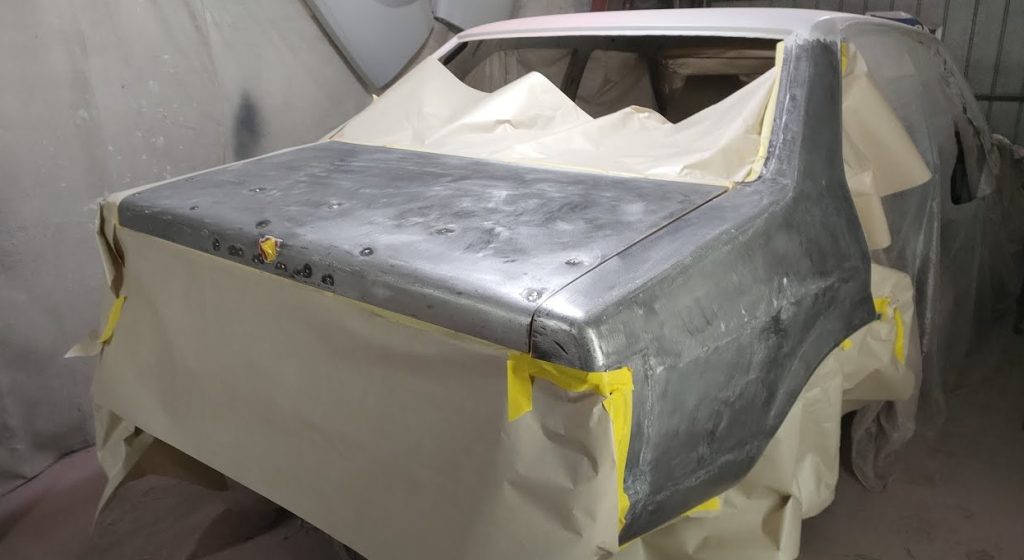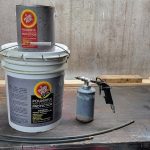Metal surfaces, with their inherent strength and durability, often become the canvas for various projects. However, when it comes to fiberglassing over bare metal, questions abound. In this extensive guide, we will not only answer the pivotal question of “Can you fiberglass over bare metal?” but also delve deeper into the nuances of the process, providing you with a wealth of information, expert insights, and practical tips to ensure your project is not just successful but truly exceptional.
The Intricate Dance of Metal and Fiberglass
Understanding the Basics
Fiberglassing over bare metal requires a meticulous approach. Can You Fiberglass Over Bare Metal? Absolutely, but success hinges on proper preparation. Ensure the metal surface is not only clean and free of rust but also adequately primed. The primer acts as a crucial intermediary, enhancing the adhesion between the metal and the fiberglass.
The Crucial Materials You’ll Need
- Fiberglass Cloth and Resin: The dynamic duo that imparts strength and resilience to your project.
- Epoxy Primer: A foundational layer, boosting adhesion and offering corrosion protection.
- Sandpaper and Sanding Blocks: Tools for preparing the metal surface, creating an ideal texture for fiberglass adhesion.
- Safety Gear: Gloves, goggles, and a respirator are non-negotiable for a secure working environment.
The Art of Fiberglassing Unveiled: A Step-by-Step Guide
1. Surface Preparation: Setting the Stage for Success
Before fiberglassing, meticulous surface preparation is imperative:
- Thoroughly clean the metal surface to eliminate contaminants such as dirt and grease.
- Employ fine-grit sandpaper to create a textured surface, promoting optimal adhesion for the fiberglass.
2. Priming the Metal: An Adhesive Foundation
The application of epoxy primer is a pivotal step:
- Apply a uniform layer of epoxy primer to the metal surface and allow it to cure. This not only enhances adhesion but also acts as a protective shield against corrosion.
3. Cutting and Fitting Fiberglass Cloth: Precision Matters
Achieving the right fit is essential for a seamless finish:
- Measure and cut the fiberglass cloth to fit the designated project area.
- Lay the cloth flat on the metal surface, ensuring it conforms without wrinkles or folds.
4. Mixing and Applying Resin: The Alchemical Blend
Resin application requires precision and attention:
- Follow the manufacturer’s instructions for resin mixing, ensuring an accurate blend.
- Apply the resin onto the metal surface using a brush or roller, ensuring even coverage.
5. Layering Fiberglass: Building Strength Gradually
Building layers is a gradual process:
- Place the cut fiberglass cloth onto the wet resin, ensuring complete saturation.
- Apply additional layers as necessary, allowing each layer to cure before adding the next.
Pro Tips and Tricks for a Seamless Finish
- Temperature Matters: Execute fiberglassing in moderate temperatures for optimal curing and bonding.
- Smooth Finish: Sand between layers to achieve a smooth, professional finish.
- Detailing Attention: Pay close attention to corners and edges to prevent air pockets and ensure uniform reinforcement.
Navigating Challenges: Solutions for Common Hurdles
1. Adhesion Issues: Defeating the Resistance
- Solution: Prioritize thorough surface preparation and use a high-quality epoxy primer for enhanced adhesion.
2. Air Bubbles: Popping the Mysteries
- Solution: Roll out the fiberglass thoroughly, and consider using a release agent on the roller to minimize air bubbles.
3. Uneven Surfaces: Smoothing the Path
- Solution: Employ sanding between layers and apply additional resin where needed for an even surface.
Beyond the Basics: Additional Insights
1. Weather Considerations: Timing Is Everything
- Plan fiberglassing projects during dry weather to prevent issues related to humidity and moisture.
2. Project-Specific Considerations: Tailoring Your Approach
- Different projects may demand variations in cloth weight and resin types. Tailor your approach based on the specific demands of your project.
3. Post-Finishing Steps: Sealing the Deal
- Once the fiberglass has cured, perform a final sanding for an impeccable finish.
4. Longevity and Maintenance: Ensuring Endurance
- Apply a clear coat or gel coat for additional protection and longevity.
- Regularly inspect and maintain fiberglassed surfaces for lasting results.
Expert Tips for Seamless Fiberglassing Over Bare Metal
Embarking on a fiberglassing project over bare metal requires a blend of precision, expertise, and a touch of finesse. To ensure your endeavor unfolds smoothly, here are some expert tips that will elevate your craftsmanship and lead you to a flawless finish.
1. Prioritize Surface Preparation: The Foundation of Success
Before diving into the fiberglass application, devote ample time to surface preparation. Cleanliness and a properly primed metal surface are the cornerstones for optimal adhesion and a lasting bond between the fiberglass and metal.
2. Invest in Quality Materials: The Building Blocks of Durability
The success of any fiberglass project lies in the quality of materials used. Opt for high-grade fiberglass cloth, resin, and epoxy primer. Cutting corners on materials can compromise the longevity and resilience of your finished product. (See Also: Can You Paint Over LINE-X? Tips and Tricks for a Flawless Finish)
3. Temperature Management: The Goldilocks Principle
Timing is crucial. Fiberglass cures best in moderate temperatures. Avoid extreme heat or cold, as these conditions can affect the curing process and the final strength of the fiberglass.
4. Layering Techniques: Gradual Strength Enhancement
When applying fiberglass layers, follow a gradual process. Allow each layer to cure properly before adding the next. This method ensures a sturdy and even distribution of fiberglass reinforcement.
5. Mind the Air Bubbles: Roll, Release, Repeat
Air bubbles can mar the surface finish. When applying resin, use a roller to meticulously roll out the fiberglass cloth. Consider using a release agent on the roller to minimize the formation of air bubbles.
6. Sand Between Layers: Smoothing the Canvas
Achieve a professional finish by sanding between layers. This not only smoothens the surface but also creates a bond between layers for added strength.
7. Corner and Edge Attention: No Room for Neglect
Corners and edges are often overlooked but demand special attention. Ensure thorough saturation of fiberglass in these areas to prevent the formation of air pockets and weak points in the structure.
8. Weather Window: Plan According to Mother Nature
Select your project days wisely. Dry weather is ideal for fiberglassing, as humidity and moisture can adversely affect the curing process and overall quality of the fiberglass finish.
9. Tailor Your Approach: Project-Specific Considerations
Different projects have different demands. Tailor your approach by considering variables such as cloth weight and resin types based on the unique requirements of your specific project.
10. Post-Finishing Seal: The Final Touch
After the fiberglass has cured, apply a clear coat or gel coat for additional protection and longevity. Regular inspections and maintenance will ensure your fiberglassed surfaces stand the test of time.
Incorporating these expert tips into your fiberglassing process will not only streamline your project but also elevate the final result to a professional standard. Happy fiberglassing! (See Also: Common Matrix Paint Problems: Tips to Troubleshoot and Restore Your Finish)
Frequently Asked Questions About Fiberglassing Over Bare Metal
Embarking on a fiberglassing project over bare metal can raise numerous questions. To guide you through the intricacies of this process, here are some frequently asked questions along with comprehensive answers to ensure you approach your project with confidence.
1. Can fiberglass be applied directly to bare metal surfaces?
Yes, fiberglass can be applied directly to bare metal surfaces. However, proper surface preparation, including cleaning and priming, is crucial for successful adhesion.
2. What type of primer is best for preparing bare metal for fiberglassing?
Epoxy primer is highly recommended for preparing bare metal surfaces. It not only enhances adhesion but also provides a protective barrier against corrosion.
3. How do I prevent air bubbles in the fiberglassing process?
To minimize air bubbles, use a roller to thoroughly roll out the fiberglass cloth. Applying a release agent to the roller can further help in preventing the formation of air pockets.
4. Can fiberglassing be done in extreme temperatures?
It is advisable to fiberglass in moderate temperatures. Extreme heat or cold can affect the curing process, potentially compromising the strength of the fiberglass.
5. How many layers of fiberglass should be applied?
The number of layers depends on the project’s requirements. It’s common to apply multiple layers, allowing each to cure before adding the next for gradual strength enhancement.
6. Is it necessary to sand between fiberglass layers?
Sanding between layers is recommended for achieving a smooth finish and promoting a strong bond between layers. It contributes to the overall professional appearance of the final product.
7. What safety precautions should be taken during fiberglassing over bare metal?
Wearing appropriate safety gear, including gloves, goggles, and a respirator, is essential. Ensuring proper ventilation in the workspace is also crucial to prevent inhaling fumes. (See Also: Is Auto Butler Worth It? Uncovering the Benefits and Drawbacks)
8. Can fiberglassed surfaces be painted?
Yes, fiberglassed surfaces can be painted. After the fiberglass has cured, you can apply paint or other finishes as desired.
9. How do I maintain fiberglassed surfaces for longevity?
Regular inspections and maintenance are key to ensuring longevity. Applying a clear coat or gel coat after curing provides additional protection against the elements.
10. Are there project-specific considerations for fiberglassing?
Yes, different projects may require variations in cloth weight and resin types. Tailor your approach based on the specific demands of your project for optimal results.
Navigating through these frequently asked questions will equip you with the knowledge needed to tackle your fiberglassing project over bare metal with confidence and precision. Happy crafting!
Conclusion: Empowered for Success
In conclusion, the affirmative response to “Can You Fiberglass Over Bare Metal?” is not just a green light; it’s an invitation to embark on a creative journey. This guide equips you not only with the fundamental steps but also with additional insights, pro tips, and solutions to common challenges.
With patience and attention to detail, you can transform bare metal surfaces into resilient, fiberglass-reinforced masterpieces. Happy crafting, and may your projects stand the test of time!



